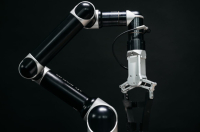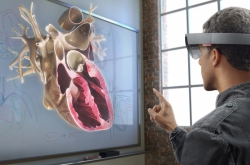Scientists from all over the world work on new types of micro- and nanoscale- robots. Medicine and biotechnologies are the most popular applications of these systems. For example, engineers at Swiss Federal Institute of Technology in Zurich developed micro-robots for targeted drug delivery, which is used to avoid toxicosis caused by medications. Micro-robots will be able to serve like surgeons.
Created by a 3D printer the robot consists of biopolymers. When the system is inside the organism, one can control it using electromagnetic fields, heat energy and lasers. Furthermore, it is planned to use the robot for operations at the cellular level. Using light pulses it will be possible to move electrons or other particles. According to the scientists, there are a lot of things to be done in order to make this system work properly.

Micro-robots can be applied to other fields. Researchers from Harvard University made a soft robot called octobot. The most challenging issue was to make the robot move without its hard shell. They created a pneumatic-based model. A chemical reaction inside the robot turns a small amount of hydrogen peroxide into a large amount of gas, which flows into the octobot’s arms and makes them move.
The researchers at Columbia University are working on other methods to control robots. Having analyzed mechanical characteristics of hydrogels they found out that they can both manipulate robots and control peculiarities of biomaterials transferred by these robots.
Speaking of energy, there are batteries that can be swallowed. The scientists at Carnegie Mellon University developed a battery, where the melanotic pigment serves as a cathode and manganese oxide as an electrode. The battery with a capacity equal to 5mW can work for 18 hours — this time is necessary for a device equipped with a small camera to pass through a gastrointestinal tract. For instance, scientists from Harvard developed a "meat capsule" robot for diagnostics, which can serve longer thanks to an "edible" battery. Such batteries can also be used for targeted drug delivery.
"The issue of energy supply is the most difficult problem of robot development. This usually limits the progress of both micro and large robots. The only widespread solution in this field is lithium-ion batteries. However they have many disadvantages like, for instance, that they can burst," commented Dmitry Kuprianov, senior lecturer at the Department of Mechatronics.

Usually engineers are inspired by nature when making engineering solutions. For example, specialists at Iowa State University of Science and Technology developed a robot, which can handle delicate objects using spiraling tentacles. This method is widely used in nature — it helps grab objects without hurting them. The scientists fabricated micro tubes just 8 millimeters long using flexible and viscous polymers called elastomers. The walls of these tubes have different width — when one pumps air into a tube, the asymmetry provokes a coiling action. These micro-robots can be used in medicine and manufacturing.
Previously when creating robots that simulate how living organisms move, developers used vertebrates as an example to follow. These days, researchers make modern robots move like caterpillars or worms. The researchers from University of Warsaw made a natural scale caterpillar soft robot, which can go uphill and push objects several times heavier than its own weight.

Scientists from the University of Tokyo made a robot, which can detect odors. The robot moves towards an
"odor target" managed by a moth. When it feels that something smells it puts a ball in motion, which runs a diving mechanism. According to the results of experiments, the robot always reaches the odor target. Despite the fact that it is not a micro-robot, this technology can be used for creating new detecting systems.
As of now, scientists pin high hopes on micro-robots that can change such fields as data storage and transfer, physics and ecology. It is planned that in future these robots will be as effective as large-scale robots.
Photo credits: sciencemag.org, fuw.edu.pl, naked-science.ru




